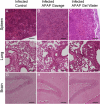Acetaminophen, a new tool for the refinement of the experimental infection of toxoplasmosis in mice
- PMID: 40594552
- PMCID: PMC12218065
- DOI: 10.1038/s41598-025-06849-2
Acetaminophen, a new tool for the refinement of the experimental infection of toxoplasmosis in mice
Abstract
In recent years, animal welfare gained increasing importance in society and especially in scientific research. It has become necessary to refine the experimental procedures as much as possible in infectiology as in our reference model, toxoplasmosis, in accordance with the 3Rs rule and various ethical concerns. Thus, the establishment of a treatment using analgesics would provide relief to animals acutely infected with Toxoplasma gondii. However, the use of analgesics should in no way alter the pathophysiology of the disease and the host immune response, so as not to interfere with the initial scientific study. Little is currently known about the use of acetaminophen (APAP) in an infectious model. In the present work, we studied the impact of APAP at a reference dose of 30 mg/kg/day in a mouse model of acute toxoplasmosis. Zoonotic, telemetric, behavioral, histological and immune parameters were analyzed to better characterize the consequences of treatment with APAP either by gavage or by self-medication in Gel Water. APAP administered by gavage did not induce cellular or tissue toxicity or alter the physiological development of the mice. In addition, the nature of Gel Water itself, independent of APAP, had an effect on the immune response. APAP improved overall well-being and slowed the onset of clinical signs without altering the physiopathology or the immune responses induced by T. gondii. These first results in mice confirmed our initial hypothesis that APAP appears to be a pharmacological tool to refine and improve animal welfare during the acute phase of toxoplasmosis. Therefore, our project has highlighted the combination of specific markers to contribute to animal welfare in mice. In the long term, the use of APAP could be extended to other infectious models with other target animal species.
Keywords: Acetaminophen; Behavior; Immune response; Mice; Toxoplasmosis; Welfare.
© 2025. The Author(s).
Conflict of interest statement
Declarations. Competing interests: The authors declare no competing interests. Ethics statement: Experiments were carried out according to EU directives and French regulations (Directive 2010/63 / EU, 2010; Rural Code, 2018; Decree n ° 2013–118, 2013, https://www.legifrance.gouv.fr/loda/id/JORFTEXT000027038013/ ). All experimental procedures have been evaluated and approved by the Ministry of Higher Education and Research (APAFIS # 2018021917268751.V3—13634). The procedures involving mice were evaluated by the Val de Loire ethics committee (CEEA VdL, committee number 19) and took place at the INRAE Platform for Experimental Infection PFIE (UE-1277 PFIE, INRAE Centre-Val-de Loire) Valley research, Nouzilly, France, https://doi.org/ https://doi.org/10.15454/1.5535888072272498e12 .
Figures












Similar articles
-
Sertindole for schizophrenia.Cochrane Database Syst Rev. 2005 Jul 20;2005(3):CD001715. doi: 10.1002/14651858.CD001715.pub2. Cochrane Database Syst Rev. 2005. PMID: 16034864 Free PMC article.
-
A rapid and systematic review of the clinical effectiveness and cost-effectiveness of paclitaxel, docetaxel, gemcitabine and vinorelbine in non-small-cell lung cancer.Health Technol Assess. 2001;5(32):1-195. doi: 10.3310/hta5320. Health Technol Assess. 2001. PMID: 12065068
-
Intravenous magnesium sulphate and sotalol for prevention of atrial fibrillation after coronary artery bypass surgery: a systematic review and economic evaluation.Health Technol Assess. 2008 Jun;12(28):iii-iv, ix-95. doi: 10.3310/hta12280. Health Technol Assess. 2008. PMID: 18547499
-
Tramadol with or without paracetamol (acetaminophen) for cancer pain.Cochrane Database Syst Rev. 2017 May 16;5(5):CD012508. doi: 10.1002/14651858.CD012508.pub2. Cochrane Database Syst Rev. 2017. PMID: 28510996 Free PMC article.
-
Systemic pharmacological treatments for chronic plaque psoriasis: a network meta-analysis.Cochrane Database Syst Rev. 2021 Apr 19;4(4):CD011535. doi: 10.1002/14651858.CD011535.pub4. Cochrane Database Syst Rev. 2021. Update in: Cochrane Database Syst Rev. 2022 May 23;5:CD011535. doi: 10.1002/14651858.CD011535.pub5. PMID: 33871055 Free PMC article. Updated.
References
-
- Russell, W.M.S., and Burch, R.L. The principles of humane experimental technique. Methuen, Wheathampstead (UK): Universities Federation for Animal Welfare (as reprinted 1992) (1959).
-
- Beauge, C. & Riou, M. Etude de l’impact et choix de l’enrichissement du milieu sur l’élevage de lignées de souris transgéniques exempts d’organismes pathogènes spécifiques (EOPS) et opportunistes. STAL Sci. Tech. Anim. Lab.48, 42–52 (2020).
MeSH terms
Substances
LinkOut - more resources
Full Text Sources
Medical

